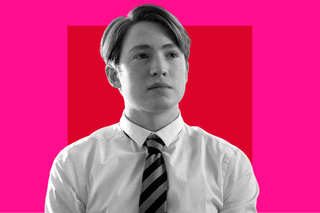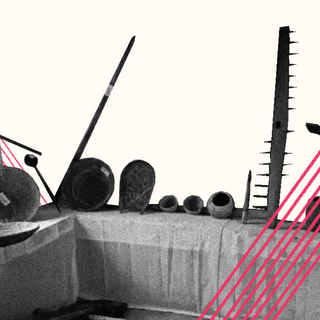
‘Heartstopper’ Actor Says He Was Forced to Come Out as Bisexual
The incident prompts renewed questions about the idea of “coming out” — and whether the closet looks the same for everyone.

Kit Connor, an 18-year-old actor who portrayed the bisexual character, Nick Nelson, in Netflix’s Heartstopper, came out as bisexual himself. But there’s a catch: he felt compelled to come out after people accused him of “queerbaiting.” “Back for a minute. I’m bi. Congrats [on] forcing an 18-year-old to out himself. I think some of you missed the point of the show. Bye,” Connor tweeted on Monday.
“We’re still all so young. To start sort of speculating about our sexualities and maybe pressuring us to come out when maybe we’re not ready,” Connor had previously said in a podcast, about how the cast of Heartstopper was being questioned about their sexuality. He had also expressed his discomfort with publicly attaching his sexuality with a label. The incident doesn’t just show how calls for authentic representation may be flawed, but also highlights how the idea of the closet itself bears scrutiny as a narrow concept.
First, the call for diverse representation in popular media is an important one — as is the call for marginalized characters to be portrayed by actors who have been there. But has also turned into a one-size-fits-all approach that doesn’t apply the same way across all identities. When it comes to sexuality, for instance, actors who portray queer characters are scrutinized for hints about their own sexuality in invasive ways. Not only does it violate their privacy, but it’s also based on the flawed premise that there’s only one way to be visible as a queer person — and it inadvertently reduces an entire identity to its public performance.
In this instance, Connor was accused of queerbaiting after he was seen holding hands with a (presumed to be) female co-star. That an innocuous gesture was weaponized against the actor speaks to a larger problem: queer people are reduced to a spectacle in the public eye. Anyone who claims — or represents — any form of queerness is bestowed with the expectation to perform, to be publicly subversive, and to be provocative in their queerness. To impose this compulsory performance is not only dehumanizing — it also undermines the many different ways to be queer.
“Coming out” of the metaphorical closet is the main event associated with queerness — it’s a singular milestone that marks both the beginning and the culmination of a person’s journey into queerness. But the centering of a particular trajectory of self-identification is arguably, and ironically, straitjacketed; it assumes a linear path toward realizing and acting upon queerness that almost mirrors how society has ordered heterosexuality. It’s for this reason that many have begun to critique the idea of the closet as a Western construct.
Related on The Swaddle:
How Bisexual Erasure Undermines What It Means to Be Queer
“Ideas of visibility and the closet have largely been shaped by white America and the gay liberation movement of the 1970s,” wrote Aisel Asan Sanchez in Archer. The idea of framing an identity around sexual experiences itself may be based in Western individualism — it imposes its own rigid boundaries, hierarchies, and trajectories onto sexuality and removes space for fluidity and play.
Consider the experiences of people in conflict zones experimenting with sexuality underground as a form of resistance. Research has shown that people don’t necessarily “identify” with a particular label — instead, sex and sexuality become subversive and radical acts of resistance for their own sake. The Iranian-American writer Ali Ahmadi notes how there’s no straightforward Farsi translation for “coming out of the closet” — consequently, there’s no vocabulary in many languages for the linear path that Western, white narratives of sexuality assume.
“Coming out as a representational form — as a genre and a tellable tale — really only emerges with the development of a movement for which coming out has salience,” wrote Suzanna Danuta Walters in the book The Tolerance Trap: How God, Genes, and Good Intentions are Sabotaging Gay Equality.
Moreover, the closet itself is constructed around the idea that sexuality can become a permanent identity because it’s fixed — in turn an idea that came about as a response to western conversations around sexuality. “It’s a concept which suggests that, prior to your coming out, you were lying and being deceptive by not sharing your sexuality or gender identity with absolutely everyone. This perceived ‘deceit’ can impact relationships. It allows no room for fluidity and presupposes that your identity is fixed, making the act of coming out again when you understand something different about your gender or sexuality feel shameful,” wrote Sadhbh O’Sullivan.
In other words: there’s no one way to be queer, and visibility is a privilege that can’t be imposed. The closet isn’t ahistorical and universal — it comes with a particular context, and is more applicable to some than others. When media and internet culture imbibe the dominant narratives about sexuality as centered around the individual who has to come out, it not only harms individuals who don’t want to, but also hurts queer culture itself — by imposing the very rigid norms that queerness challenges.
As the incident with Kit Connor shows, the way we’ve framed conversations about coming out has been with a white, Western lens that shaped dominant queer cultures. It hurts white people themselves — and moreover, it takes agency away from people, rather than being an empowering act of resistance. As queer organizer Rodney S. Williams Jr said in a blog: “With coming out, we give others the opportunity to reject our visibility, as if it’s their choice.”
Rohitha Naraharisetty is a Senior Associate Editor at The Swaddle. She writes about the intersection of gender, caste, social movements, and pop culture. She can be found on Instagram at @rohitha_97 or on Twitter at @romimacaronii.
Related


How Communities Offer Joy, Belongingness to Disabled People – In Both Reel and Real Life
